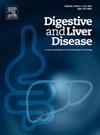glp1受体激动剂对肝移植后糖尿病的影响-单中心研究
IF 3.8
3区 医学
Q1 GASTROENTEROLOGY & HEPATOLOGY
引用次数: 0
摘要
近50%接受肝移植(LT)的患者可观察到代谢综合征,这决定了心血管疾病的高风险和移植物损伤的加速。其中一种或多种成分(肥胖、胰岛素抵抗或糖尿病、高血压和血脂异常)可能在肝移植时已经存在,也可能在移植后出现,导致代谢功能障碍相关脂肪变性肝病(MASLD)的复发或新发。移植后MASLD可在移植后1年观察到高达50%的患者。免疫抑制相关副作用在移植后胰岛素抵抗、糖尿病、高血压、血脂异常和体重增加的发展中起着不可忽视的作用。近30%的肝移植受者在肝移植后出现新发糖尿病,高达40%的肝移植受者在肝移植后3年出现肥胖。因此,在上述危险因素的管理中,早期干预似乎至关重要,以减少代谢综合征和MASLD的复发或新发,心血管风险和移植物损伤。GLP-1受体激动剂(GLP1-RAs)治疗成人2型糖尿病在降低HbA1c和体重方面取得了最佳效果,仅有轻至中度不良反应(主要是恶心、腹泻、呕吐、腹部不适)。它们还被批准用于降低糖尿病和心血管疾病患者心血管事件的风险。在没有糖尿病的超重和肥胖人群中也观察到体重减轻。根据这些结果,在LTR合并糖尿病患者中进行了一些小型回顾性研究,显示GLP-1RAs在实现更好的血糖控制和减轻体重方面的功效。我们的研究旨在评估每周GLP1-RAs注射在LTR合并糖尿病队列中的有效性和安全性。材料和方法我们回顾性评估了2014年至2023年间在我们中心接受肝移植并接受GLP1-RA(西马鲁肽、利拉鲁肽或杜拉鲁肽)治疗糖尿病的所有患者。每次随访时记录体重、体重指数、Hb1Ac值、ALT和AST值、不良事件和停药情况。结果以均数±标准差表示,必要时采用配对t检验。结果共纳入24例患者。我们人口的特征如表1所示。平均年龄59.0(±6.76)岁,女性29.2%。酒精是肝硬化的主要病因,13例发生HCC。如表2所示,治疗6个月后,体重和BMI均有显著降低(88.1±17.7,p = 0.015;29.1±4.6,p = 0.026)。12个月后下降更为明显(分别为84.6±16.7,p = 0.003;28.4±4.4,p = 0.011)。HbA1c值和转氨酶水平的降低也被观察到,尽管没有统计学意义。没有记录到重大影响;只有1名患者(4%)出现持续恶心导致停药。不需要调整免疫抑制剂量。在这项单中心回顾性分析中,我们发现,在LTR合并糖尿病患者中,每周GLP1-RAs治疗是安全的,并且在治疗6个月和12个月后可诱导早期和相关的体重减轻。需要更大的多中心研究和更长的随访时间来评估持续体重减轻、长期移植结果以及GLP1-RAs在降低LTR心血管风险中的潜在作用。本文章由计算机程序翻译,如有差异,请以英文原文为准。
Impact of GLP1-receptor agonists on diabetes after liver transplantation - A single-center experience.
Background
Metabolic syndrome can be observed in nearly 50% of patients undergoing liver transplantation (LT), determining a higher risk for cardiovascular disease and accelerated graft damage. One or more of its components (obesity, insulin resistance or diabetes, hypertension and dyslipidemia) may be already present at the time of LT or may develop in the post-transplant setting, contributing to the recurrence or de novo development of metabolic dysfunction-associated steatotic liver disease (MASLD). Post-transplant MASLD can be observed in up to 50% of patients 1 year after LT. Immunosuppression related side effects play a non-negligible role in the development of insulin resistance, diabetes, hypertension, dyslipidemia and weight gain in the post-transplant setting. Nearly 30% of liver transplant recipients develop new-onset diabetes mellitus after LT and up to 40% of LT recipients are obese 3 years after LT. It seems therefore of pivotal importance the need for an early intervention in the management of the above-mentioned risk factors, to reduce recurrence or de novo development of metabolic syndrome and MASLD, cardiovascular risk and graft damage.GLP-1 receptor agonists (GLP1-RAs) therapy has achieved optimal results in the treatment of adults with type 2 diabetes in terms of reduction of HbA1c and weight, with only mild to moderate adverse effects (mainly nausea, diarrhea, vomiting, abdominal discomfort). They have also been approved for reducing the risk of cardiovascular events in patients with diabetes and cardiovascular disease. A reduction in body weight has also been observed in overweight and obese individuals without diabetes. Following these results, some small retrospective studies have been performed in LTR with diabetes, showing the efficacy of GLP-1RAs in achieving better glycemic control and a reduction in body weight. AIMOur study aimed to assess the efficacy and safety of weekly GLP1-RAs injection in a cohort of LTR with diabetes.
Material and Methods
We retrospectively evaluated, between 2014 and 2023, all patients who underwent LT at our center and were treated with a GLP1-RA (semaglutide, liraglutide or dulaglutide) for diabetes. Body weight, body mass index, Hb1Ac values, ALT and AST values, adverse events and drug discontinuation were recorded at each follow-up visit. Results were expressed as mean ± SD, paired t-test was used when needed.
Results
A total of 24 patients were included in the study. The characteristics of our population are shown in Table 1. The mean age was 59.0 (± 6.76) years, 29,2% were female. Alcohol was the main etiology of cirrhosis, and 13 patients had HCC.As shown in Table 2, after 6 months of treatment, there was a significant reduction in body weight and BMI (88.1 ± 17.7, p = 0.015; 29.1 ± 4.6, p = 0.026, respectively). The reduction was even more pronounced after 12 months (84.6 ± 16.7, p = 0.003; 28.4 ± 4.4, p = 0.011, respectively). A reduction in HbA1c values and transaminases levels was also observed, although without statistical significance. No major effects were recorded; only one patient (4%) experienced persistent nausea leading to therapy discontinuation. No adjustment in immunosuppression dosages was needed.
Conclusions
In this single-center retrospective analysis, we showed that, in LTR with diabetes, weekly GLP1-RAs therapy is safe and induces early and relevant weight loss after six and twelve months of treatment. Larger multicenter studies with longer follow-up are needed to assess sustained weight loss, long-term graft outcomes, and the potential role of GLP1-RAs in reducing cardiovascular risk in LTR.
求助全文
通过发布文献求助,成功后即可免费获取论文全文。
去求助
来源期刊

Digestive and Liver Disease
医学-胃肠肝病学
CiteScore
6.10
自引率
2.20%
发文量
632
审稿时长
19 days
期刊介绍:
Digestive and Liver Disease is an international journal of Gastroenterology and Hepatology. It is the official journal of Italian Association for the Study of the Liver (AISF); Italian Association for the Study of the Pancreas (AISP); Italian Association for Digestive Endoscopy (SIED); Italian Association for Hospital Gastroenterologists and Digestive Endoscopists (AIGO); Italian Society of Gastroenterology (SIGE); Italian Society of Pediatric Gastroenterology and Hepatology (SIGENP) and Italian Group for the Study of Inflammatory Bowel Disease (IG-IBD).
Digestive and Liver Disease publishes papers on basic and clinical research in the field of gastroenterology and hepatology.
Contributions consist of:
Original Papers
Correspondence to the Editor
Editorials, Reviews and Special Articles
Progress Reports
Image of the Month
Congress Proceedings
Symposia and Mini-symposia.
 求助内容:
求助内容: 应助结果提醒方式:
应助结果提醒方式:


